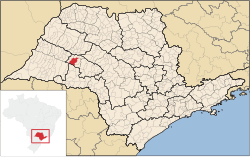Tupã is a municipality in the state of São Paulo in Brazil. The population is 65,570 (2020 est.) in an area of 628 km2.[3] The city is located in the Alta Paulista Region and it is located 530 km (329.32 sq mi) from capital São Paulo. It was founded on October 12, 1929 by Luiz de Souza Leão a business man that chose the region that were tropical forest. The city is located between 2 rivers: Aguapeí River and Rio do Peixe.
Tupã | |
|---|---|
| Municipality of Tupã | |
 Location in São Paulo | |
| Coordinates: 21°56′5″S 50°30′49″W / 21.93472°S 50.51361°W | |
| Country | |
| Region | Southeast |
| State | |
| Founded | 12 October 1929 |
| Area | |
| • Total | 628 km2 (242 sq mi) |
| Population (2020)[1] | |
| • Total | 65,570 |
| • Density | 100/km2 (270/sq mi) |
| Time zone | UTC-03:00 (BRT) |
| HDI (2010) | 0.771 – high[2] |
| Website | tupa |
The city is named after a god of thunder in the Guaraní mythology.[citation needed]
History
editThe municipality was created by state law in 1938.[4]
Demographics
edit
| ||||||||||||||||||||||||||||||||||||||||||||||||||||||||
Media
editIn telecommunications, the city was served by Telecomunicações de São Paulo.[8] In July 1998, this company was acquired by Telefónica, which adopted the Vivo brand in 2012. The company is currently an operator of cell phones, fixed lines, internet (fiber optics/4G) and television (satellite and cable).[9]
Religion
editChristianity is present in the city as follows:
Catholic Church
editThe Catholic church in the municipality is part of the Roman Catholic Diocese of Marília.[10]
Protestant Church
editThe most diverse evangelical beliefs are present in the city, mainly Pentecostal, including the Assemblies of God in Brazil (the largest evangelical church in the country),[11][12] Christian Congregation in Brazil,[13] among others. These denominations are growing more and more throughout Brazil.
References
edit- ^ IBGE 2020
- ^ "Archived copy" (PDF). United Nations Development Programme (UNDP). Archived from the original (PDF) on July 8, 2014. Retrieved August 1, 2013.
{{cite web}}: CS1 maint: archived copy as title (link) - ^ "IBGE - Instituto Brasileiro de Geografia e Estatística". Retrieved 9 August 2016.
- ^ "Municípios Paulistas". www.al.sp.gov.br (in Portuguese). Retrieved 2024-06-26.
- ^ "Censos Demográficos (1991-2022) | IBGE". www.ibge.gov.br (in Portuguese).
- ^ "Censos Demográficos (1872-1980) | IBGE". biblioteca.ibge.gov.br (in Portuguese).
- ^ "Biblioteca Digital Seade | Fundação Seade". bibliotecadigital.seade.gov.br (in Portuguese).
- ^ "Creation of Telesp - April 12, 1973". www.imprensaoficial.com.br (in Portuguese). Retrieved 2024-06-14.
- ^ "Our History - Telefônica RI". Telefônica. Retrieved 2024-06-14.
- ^ "São Paulo (Archdiocese) [Catholic-Hierarchy]". www.catholic-hierarchy.org. Retrieved 2024-06-23.
- ^ "Campos Eclesiásticos". CONFRADESP (in Portuguese). 2018-12-10. Retrieved 2024-06-23.
- ^ "Arquivos: Locais". Assembleia de Deus Belém – Sede (in Portuguese). Retrieved 2024-06-23.
- ^ "Localidade - Congregação Cristã no Brasil". congregacaocristanobrasil.org.br (in Portuguese). Retrieved 2024-06-23.
External links
edit- (in Portuguese) Tupã City Hall Website
- (in Portuguese) Tourism Information (provided by the City Hall)
- (in Portuguese) Satellite image of Tupã on Google Maps








